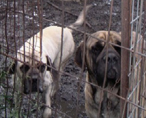 issue |
issue > veterinarians > the missing link
There are many veterinarians who have witnessed animal neglect and cruelty. When animals are rescued from inhumane breeders, they are often the first responders, providing medical care. It’s been argued, however, that veterinarians (and their associations) are the missing links as to why more legislation, protecting animals, has not been passed in Minnesota and why many inhumane breeders continue to operate. If veterinarians are silent, no action is taken. Just as with doctors for humans, it is the responsibility of the veterinarian to report signs of neglect or abuse and to monitor and report conditions that could contribute to the spread of disease or health concerns. Veterinarians who choose to be the ‘vet of record’ for commercial breeders, and do not report animal neglect or suffering if seen (physical or psychological), have placed revenues before their professional oath. If you are concerned about a breeder’s veterinarian and wish to file a complaint, go to: Minnesota Board of Veterinary Medicine Reputable veterinarians do not tolerate animal suffering in any form. Please, if you are a veterinarian, call your State legislators directly or contact us. Your voice is important.
Why do some veterinarians choose to ignore an animal’s health and safety? The treatment of animals is a sensitive and controversial issue, which has created divisions even within the veterinarian community itself. Veterinarians vary in their professional attitudes about animals and what is considered humane. The consequence of this attitude, in regards to dog and cat breeding, is that some veterinarians may turn a blind eye to inhumane conditions and practices because of income earned. Some veterinarians may also be ignorant of new scientific research regarding animal pain or what’s considered inhumane. They continue to do what they’ve always been doing, even though the veterinarian community has reversed its opinion. As an example, in order to keep the noise of barking to a minimum (considered a nuisance to people), one Morrison County breeder stated he would debark his 500 adult dogs. (Debarking is a surgical procedure that removes the dog’s vocal cords.) The veterinarian of record for this breeder testified that he had debarked about 10,000 dogs and would conduct the procedure for this breeder. This veterinarian did not question the procedure, even though the veterinarian community considers it inhumane. Even Morrison County asked that debarking not be used. In a letter to this breeder (during the breeder’s request for a conditional use permit), the Morrison County administrator and attorney stated: “We have learned that surgical debarking is overwhelmingly disfavored within the veterinary community and many allege that it is inhumane. It is also a permanent and irreversible approach to the problem of noise. As such, we encourage the use of barking collars in place of surgical debarking. While we realize that this is ultimately your choice, not ours, we will not defend your use of the surgical practice to any or all inquirers.” The breeder stated he would use shock collars.
Veterinarian attitudes are changing Over the past years, many veterinarians have challenged the old-school thinking and are actively leading the charge to protect animals from harm and pain. Examples:
The fear of change Some science-based (research) organizations, however, still fear “lay people” (non-scientists) having an opinion about animal care rules and regulations. This fear often results in opposition to legislation, which requires rule-making — setting clear and specific guidelines for the benefit of the animal, not just the benefit of the human. Individual veterinarians, their associations and related medical and research organizations have varied in their beliefs about what constitutes humane treatment of animals and the value of life. Today, in Minnesota, many veterinarians strive for humane practices, but agreeing on the right legislation, language, and policies that truly and pro-actively protect animals is still a struggle.
The value of an animal “…if one person is unkind to an animal, it is considered to be cruelty, but where a lot of people are unkind to animals, especially in the name of commerce, the cruelty is condoned and, once sums of money are at stake, will be defended to the last by otherwise intelligent people.”
Supporting Links
|
 |
"));